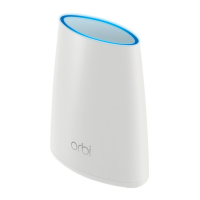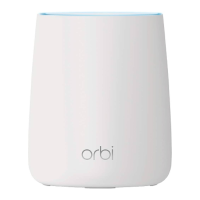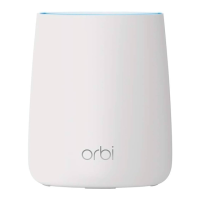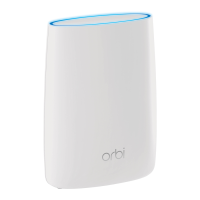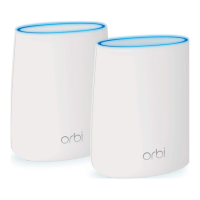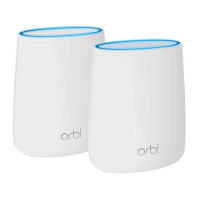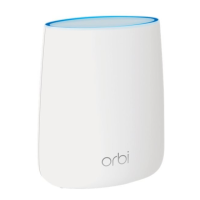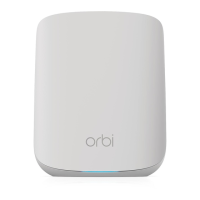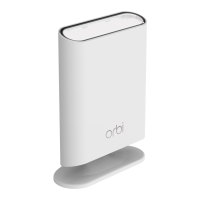Table 9. Technical specifications for the Orbi satellite (Continued)
DescriptionFeature
FCC Part 15, Subpart B, Class B
IECS-003, Class B
EN 55032, EN 55035, Class B
AS/NZS CISPR 32, Class B
Electromagnetic emissions
One RJ-45 Multi-Gigabit Ethernet port compatible with 10GBASE-T,
5GBASE-T, 2.5GBASE-T, and 1000BASE-T
LAN
Two RJ-45 Ethernet ports compatible with 2.5GBASE-T, 1000BASE-T,
100BASE-T, and 10BASE-TX
Maximum wireless signal rate complies with the IEEE 802.11 standard.
Note: Maximum wireless signal rate derived from IEEE Standard 802.11
specifications. Actual throughput can vary. Network conditions and
environmental factors, including volume of network traffic, building
materials and construction, and network overhead, lower actual data
throughput rate.
WiFi
2.4 GHz: backhaul and fronthaul, Max 1147 Mbps
5 GHz fronthaul: 5765 Mbps
5 GHz backhaul: 8647 Mbps
6 GHz fronthaul: 11530 Mbps
Radio data rates
IEEE® 802.11b/g/n/ax
2.4 GHz—1024-QAM support
Radio 1 data encoding standards
IEEE 802.11a/n/ac/ax/be
5 GHz—4K-QAM support
Radio 2 data encoding standards
IEEE 802.11a/n/ac/ax/be
5 GHz—4K-QAM support
Radio 3 data encoding standards
IEEE 802.11a/n/ac/ax/be
6 GHz—4K-QAM support
Radio 4 data encoding standards
200Maximum number of connected
devices
2.412–2.462 GHz (US)2.4 GHz operating frequency range
5.18–5.24 GHz and 5.745–5.825 GHz (US)5 GHz operating frequency range
U-NII-5 (5.925-6.425 GHz)
U-NII-6 (6.425-6.525 GHz)
U-NII-7 (6.525-6.875 GHz)
U-NII-8 (6.875-7.125 GHz)
Low-power access point (indoor
only)
6 GHz operating frequency range
Client connected to low-power
access point
WPA2-PSK + WPA3-Personal
WPA3-Personal
802.11 security main WiFi network
User Manual168Factory Settings and Technical
Specifications
Whole Home Quad-Band Mesh WiFi 7 System

